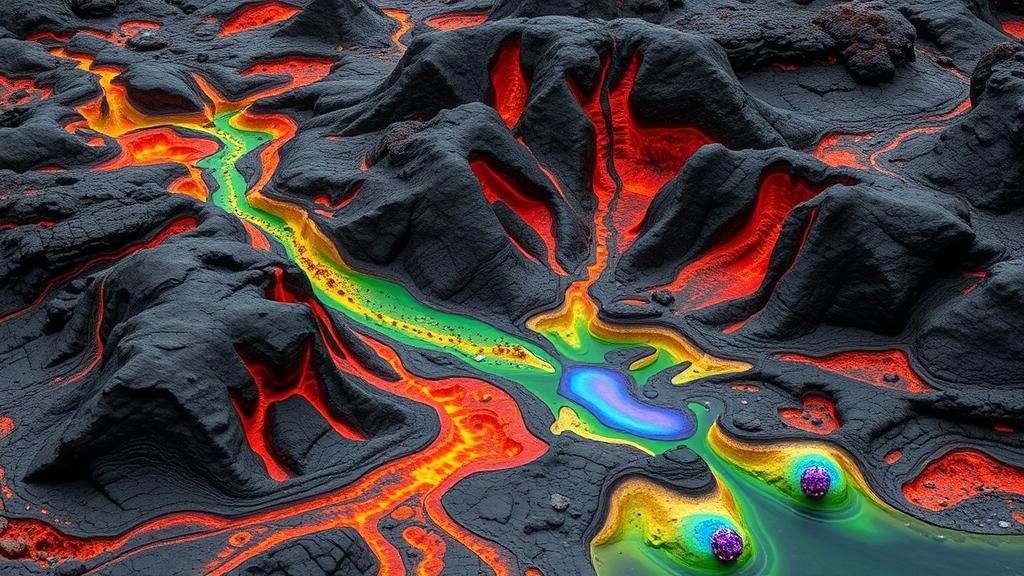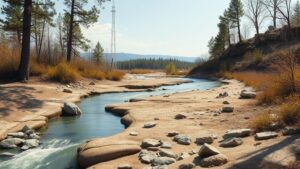Mapping Ancient Lava Flows to Predict Gem and Mineral Deposits
Mapping Ancient Lava Flows to Predict Gem and Mineral Deposits
The exploration and extraction of gemstones and minerals are critical components of the global economy, fueling industries ranging from technology to jewelry. This article delves into how mapping ancient lava flows can serve as a predictive tool for locating gem and mineral deposits. By understanding the geological processes that shape these deposits, geologists can improve exploration efficiency and target specific areas with a higher likelihood of finding valuable resources.
The Geological Significance of Lava Flows
Lava flows, formed from volcanic activity, play a significant role in shaping the Earths crust and influence the distribution of minerals. When lava erupts from a volcano, it can carry with it various minerals and gems that crystallize as the molten rock cools and solidifies. Understanding the properties of different lava flows is essential for geologists seeking to locate potential mineral deposits.
Several factors contribute to the mineralization process associated with ancient lava flows:
- The composition of the lava, which can vary significantly; for example, basalt is rich in iron and magnesium.
- The cooling rate of the lava, as slower cooling often results in larger crystal formation.
- Post-volcanic activity, such as hydrothermal processes, which can concentrate and redistribute minerals.
Historical Context and Case Studies
The practice of utilizing ancient lava flows for mineral exploration dates back to early geological surveys in the 19th century. For example, the eruption of Kilauea in Hawaii, which began in 1983, provided a modern case study where researchers mapped lava flows to identify potential mineral deposits. basaltic flows were meticulously documented, revealing significant deposits of olivine and other gemstone minerals.
Another important case is found in the Deccan Traps region of India, where extensive basalt lava flows occurred between 60 and 68 million years ago. These flows are now known to house a variety of gemstones, including diamonds and agates, which can be traced back to the volcanic activity in that region. By examining the geochemical signatures of the tracked flows, researchers can make educated predictions about the depth and richness of potential deposits.
Techniques for Mapping Lava Flows
Mapping ancient lava flows involves a combination of field studies, remote sensing technologies, and geophysical methods. Some key techniques include:
- Geological Mapping: Geologists perform detailed field surveys, utilizing GPS technology and geological tools to record the extent and characteristics of lava flows.
- Remote Sensing: Satellite imagery and aerial surveys allow for large-scale observation of volcanic terrains, helping to identify flow patterns that are not easily visible from the ground.
- Geochemical Analysis: Samples of the lava are analyzed for their mineral content using techniques like X-ray fluorescence (XRF) or scanning electron microscopy (SEM). This analysis provides insights into the potential mineralization characteristics of a given flow.
Applying Lava Flow Mapping to Mineral Exploration
Once lava flows have been mapped and analyzed, geologists can apply this data to assess mineral exploration opportunities. This application typically follows these steps:
- Identifying Anomalies: By correlating geological features with mapped lava flows, geologists can identify areas where mineral deposits are likely to accumulate.
- Targeted Drilling: Based on the mapping results, targeted drilling can be conducted in areas identified as high-potential zones, thereby increasing the efficiency and likelihood of successful exploration.
Challenges and Future Outlook
Despite the promise of mapping ancient lava flows for mineral exploration, several challenges persist:
- Geological Diversity: The variety of geological conditions can complicate the accuracy of predictions. Different regions may exhibit distinct mineral associations that are not easily generalized.
- Technological Limitations: While advancements have been made, the technologies used in remote sensing and geochemical analysis continue to evolve, requiring ongoing education and adaptation among geologists.
Looking to the future, integrative approaches combining artificial intelligence and machine learning algorithms with existing geological models could significantly enhance the predictive capabilities of mapping lava flows. By processing vast amounts of geological data, these technologies can identify patterns and correlations that may have previously gone unnoticed, ultimately leading to more productive exploration efforts.
Conclusion
Mapping ancient lava flows presents a valuable method for predicting the locations of gem and mineral deposits. Through geological mapping, remote sensing, and advanced analytical techniques, geologists can glean insights into the mineralization processes associated with volcanic activity. As technology continues to advance, the accuracy and efficacy of these mapping efforts will likely increase, paving the way for enhanced exploration strategies and more sustainable extraction practices.
To wrap up, an understanding of the connection between ancient lava flows and mineral deposits not only serves as a tool for resource prediction but also contributes to the broader field of geological research, advancing our knowledge of Earth’s dynamic processes.



